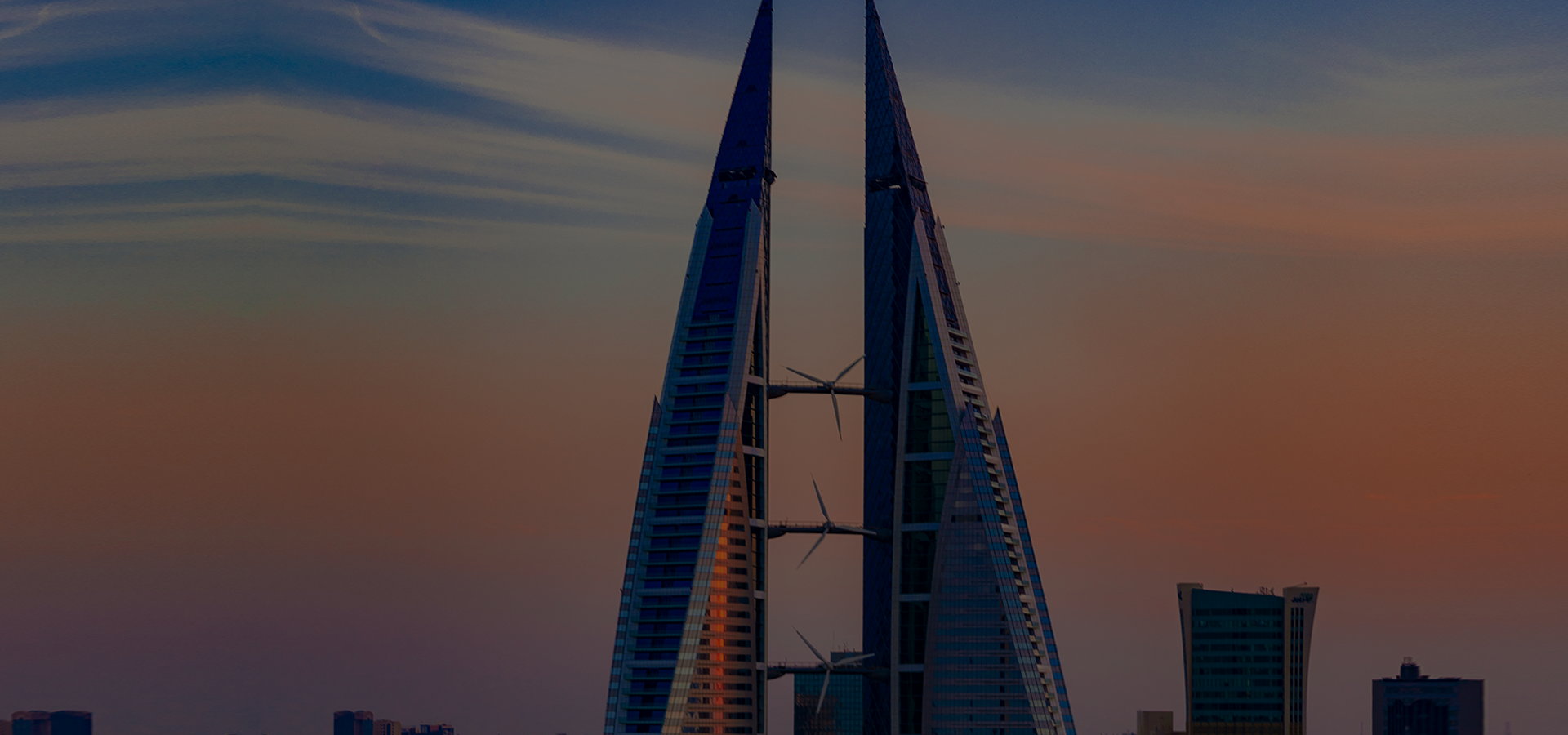Sustainable Energy In Bahrain
- Overview of the Energy Scene
- Current Status
- National Energy Targets
- Pathways to Sustainable Energy
- Study Spotlight
The Kingdom of Bahrain is considered a net energy exporter, i.e., it exports more energy than it consumes. This is primarily due to being an oil and gas producer and exporter. The primary energy source for electricity generation in the Kingdom is natural gas. The Kingdom’s electrical energy needs are catered for primarily through six power stations, all of which utilize natural gas as their fuel source. These stations are Muharraq, Al Ezzel, Al Dur, Hid, Sitra and Riffa.
The Kingdom’s energy use has increased drastically within the past four decades, from 40 TWh in 1980 to over 200TWh in 2016 (Our World in Data, 2020). This is primarily due to Bahrain’s population rise within that time frame, going from approximately 360 thousand in 1980 to over 1.7 million in 2021 (Country Economy, 2022). While varying from year to year, energy use per person has remained relatively stable since 1980, with energy use per person averaging approximately 140,000 kWh.
The National Sustainable Energy Authority (SEA) set a target of increasing renewable energy efficiency by 6% in 2025, and having 5% of the Island’s energy demand met by renewable sources by 2025 and 10% by 2035. As a result of the National Renewable Energy Action Plan (NREAP) + (NREAP-Full-Report.pdf) and National Energy Efficiency Action Plan (NEEAP) (NEEAP_full-report.pdf), Bahrain achieved its 6% energy efficiency target in 2019 and reached 95% of its 2025 renewable energy target in 2021 (International Trade Administration, 2021).
The energy sector is the most significant contributor to greenhouse gas emissions in the Kingdom. The Sustainable Energy Authority (SEA) was established per Decree Law No. (87) of 2019 + (DecreeLaw_87_2019.pdf), with the specific mandate of supporting and expediting the Kingdom’s adoption of renewable energy sources to place the country on a path towards decarburization.This will be accomplished through the SEA’s NREAP and NEEAP.
The NEEAP aims to reduce the current burden placed on the country’s energy grid by setting policies to increase Bahrain’s energy efficiency. The NREAP seeks to increase the Islands’ use of renewable energy sources, such as wind and solar, through its initiatives and determining policies to increase private sector adoption.
In addition, consideration has been given to incorporate waste-to-energy. The SEA is in the process of implementing a 50-megawatt solar initiative, which involves installing solar panels atop governmental buildings. Moreover, there are plans to develop a 100-megawatt solar farm where Askar Landfill currently sits. Due to land scarcity in Bahrain, floating solar is also being considered.
Bahrain has several privately-owned solar providers and a company known as Solar One which is the first manufacturer in Bahrain to produce solar panels. Bahrain’s Net Metering Policy, approved in 2017, involves the installation of bi-directional meters in homes that monitors both electricity use and generation. This allows residents who install solar panels in their homes to send the energy produced into the grid. The surplus energy produced is then credited and deducted from future electricity bills.
- Research Article | Offshore wind energy potential for Bahrain via multi-criteria evaluation | (2020) (Offshore wind energy potential for Bahrain via multi-criteria evaluation.pdf)
This paper highlights Bahrain’s limited landmass, increasing demand for energy and global commitments to reduce greenhouse gas emissions to consider the potential for offshore wind energy generation in Bahrain. An initial plan for potential sites to install offshore wind technology, as well as exclusion areas where development would be unsuitable (due to physical and safety constraints) are outlined. The paper defines 10 favorable sites for offshore wind generation that may potentially supply 2.68 TWh/year, the equivalent to approximately 10% of the Kingdom’s annual electricity consumption.
- Research Article | The Transition in Solar and Wind Energy Use in Gulf Cooperation Council Countries (GCCC) | (2022) (The Transition in Solar and Wind Energy Use in GCCC.pdf)
This paper references the IRENA report which states that based on the current renewable energy targets in place in the GCCC to be achieved by 2030, there is a potential to reduce the use of oil by 23%, reduce carbon dioxide emissions by 22% as well as reduce the use of water in the power sector by 17%. Section 4.2 highlights Bahrain’s progress in the renewable energy sector where the targets, as set by the NREAP and NREEP are outlined. The paper concludes with suggestions in sustainable energy investments such as electric vehicles, building integrated PV or building integrated wind turbines, rooftop PV for small scale installation and solar, wind and water desalination.
- Workshop Presentation | Investigating the Obstacles of Renewable Energy Desalination Developments in the Middle East | EU GCC Clean Energy Network II: Clean Energy R&I Collaboration and Funding Opportunities workshop (2016) | Dr. Hanan Al Buflasa (Investigating the Obstacles of Renewable Energy Desalination Developments in the Middle East |.pdf)
In this workshop, Dr. Hanan Al Buflasa covered Bahrain’s position with limited renewable fresh water resources, with Saudi Arabia possessing the highest in the GCC (635 gallons/year) and Bahrain second to last (25 gallons/year) followed by Kuwait (10 gallons/year). The topics covered in the workshop include: desalination systems in the Middle East and integrating it with renewable energy (RE), solar stills, solar thermal desalination, water and power demand in Bahrain, as well as conventional thermal technologies.
She concluded with the following:
- The demand for water and power are not correlated.
- The interdependency of water and energy systems.
- The need to address the challenges related to the integration of renewable energy into the power-water system
Information Sources and References
- Our World in Data. (2020). Bahrain: Energy Country Profile. Available Online, Accessed on 26 April 2022<https://ourworldindata.org/energy/country/bahrain>
- Country Economy, (2022). Bahrain Population. Available Online, Accessed on 26 April 2022 <https://countryeconomy.com/demography/population/bahrain?year=1980>
- NREAP. (2016). National Renewable Energy Action Plan (NREAP) Available Online, Accessed on 26 April 2022 <https://www.sea.gov.bh/nreap/>
- NEEAP. (2016). National Energy Efficiency Action Plan (NEEAP) Available Online, Accessed on 26 April 2022 <https://www.sea.gov.bh/neeap/>
- Bahrain Country Commercial Guide. (2021). Renewable Energy. Available Online, Accessed on 27 April 2022, from <https://www.trade.gov/country-commercial-guides/bahrain-renewable-energy#:~:text=Despite%20increased%20energy%20consumption%20resulting,six%20years%20head%20of%20schedule>
- Decree Law No. (87) of 2019 | Establishing the Sustainable Energy Authority https://www.legalaffairs.gov.bh/HTM/D8719.htm
- Solar One | Bahrain’s first solar panel manufacturer. (2021). Retrieved 27 April 2022, from https://solarone.me/
- Sustainable Energy Authority. (2017.) Net Metering Policy. Available Online, Acessessed on 27 April 2022, from https://www.sea.gov.bh/netmetering-3/
- Elgabiri, M., Palmer, D., Al Buflasa, H., & Thomson, M. (2020). Offshore wind energy potential for Bahrain via multi-criteria evaluation. Wind Engineering, 45(4), 838-856. doi: 10.1177/0309524×20925399
- Alnaser, N., Albuflasa, H., & Alnaser, W. (2022). The Transition in Solar and Wind Energy Use in Gulf Cooperation Council Countries (GCCC). Renewable Energy And Environmental Sustainability, 7, 4. doi: 10.1051/rees/2021034
- Al Buflasa, D. (2016). Renewable Energy Desalination: moving forward for collaboration. Presentation, EU GCC Clean Energy Network II Clean Energy R&I Collaboration and Funding Opportunities workshop. Available Online, Accessed on 27 April 2022 <https://www.eugcc-cleanergy.net/sites/default/files/events/WREC17/WREC2016_06.%20Dr.Hanan%20AlBuflasa_University%20of%20Bahrain.pdf>



